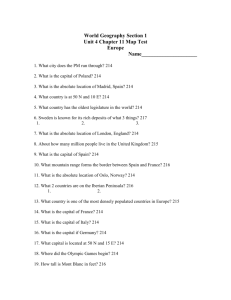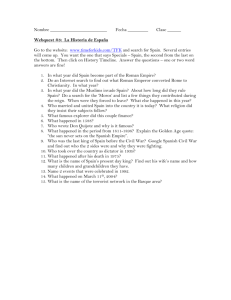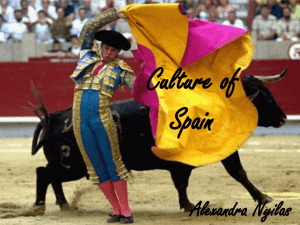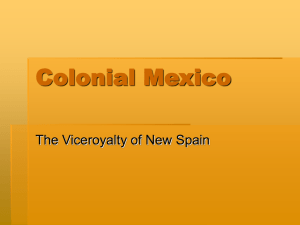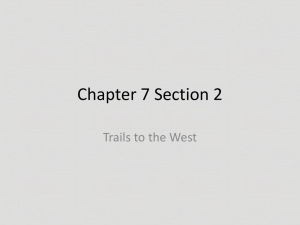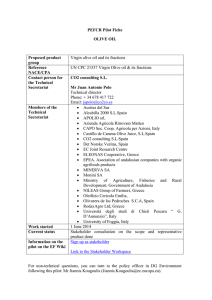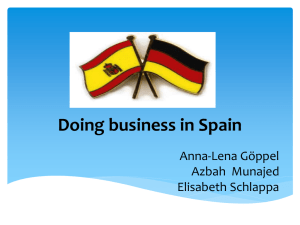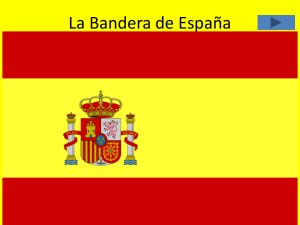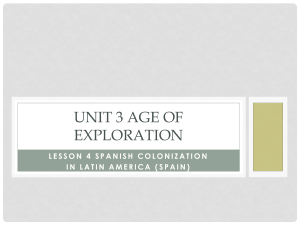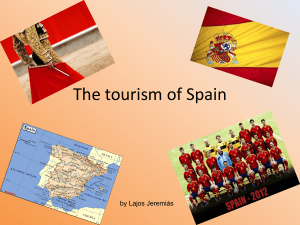Brief history of Spain
advertisement
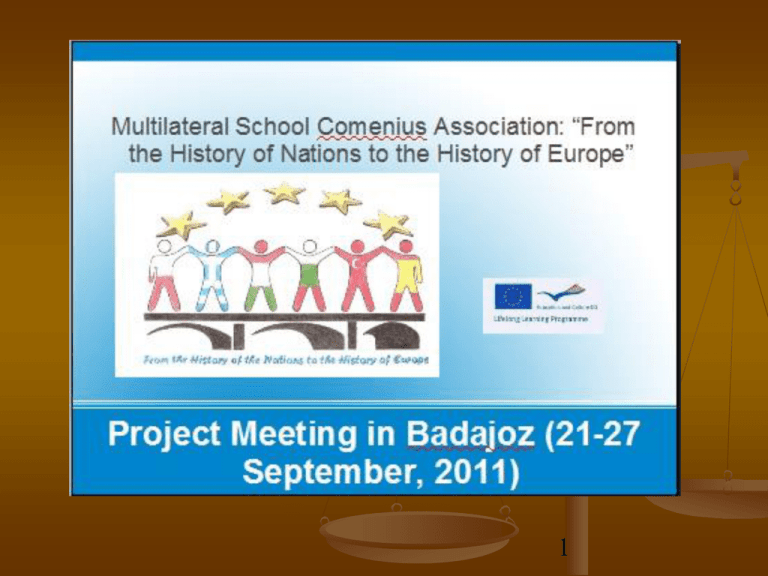
1 BRIEF HISTORY OF SPAIN 2 GEOGRAPHICAL CONDITIONS THE PENINSULAR NATURE OF THE TERRITORY explains a history related to the sea, from which extensive influences arrived. 3 GEOGRAPHICAL CONDITIONS BRIDGE THAT UNITES EUROPE AND NORTH AFRICA, forming a link joining historical and cultural factors coming from the two continents. 4 PREHISTORY (600.000 BC-circa 3.000 BC) STONE AGE Paleolithic and Neolithic METAL AGE Copper, Bronze and Iron FIRST INVASIONS: Celts, Phoenicians, Greeks and Carthaginians. 5 Paleolithic: we lived in caves, hunted and collected wild fruit. 6 7 Paleolithic Cave painting : Cave of Altamira The cave paintings in Altamira are the biggest prehistorical painting system known in Europe. 8 NEOLITHIC Towards the year 5500 BC we discover agriculture, cattle shepperding and pottery. Around 3700 BC: the megalithic culture appears. This early form of architecture devices burial buildings. 9 Metal Age: the beginning of architecture with large stone monuments called DOLMENS. 10 The first invasions: THE CELTS They arrived at the Iberian Peninsula in the first millenium before Christ and occupied the north. 11 Also during the first millenium before Christ, Phoenicians and Greeks, great travellers and traders, arrived from the other side of the Mediterranean. 12 IBERIANS Along with the Celts, the other ethnic group that lived in the Iberian Peninsula. The name of our Peninsula derives from these people. 13 And then the Romans came. 14 ROMAN HISPANIA The process of acquiring language, customs, culture and economy from Rome is called Romanization. This process means the unification of most European nations and peoples. 15 MAP OF THE ROMAN EMPIRE 16 ROMAN SPAIN 17 ROMAN ARCHITECTURE MÉRIDA THEATRE 18 AL-ANDALUS: ISLAMIC SPAIN Muslim invasion: In the 8 century (711 AD) Muslims from the East and North Africa control most part of the territory. Spain became al-Andalus. 19 MAP OF THE LAND UNDER ISLAMIC CONTROL 20 CÓRDOBA MOSQUE ISLAMIC ART 21 ISLAMIC ART: NAZARI DINASTY THE ALHAMBRA OF GRANADA 22 The conquest refers to the historical period in the Iberian Peninsula which goes from 718 to 1492 and which is characterized by the peaceful coexistence of Christians, Jews and Muslims within the country and the slow conquest of the land by Christian Kingdoms from the north. 23 24 The catholic kings ISABELLA AND FERDINANDO: a dynastic alliance Isabella and Ferdinand culminated the Christian Conquest. The territory became one single nation: Spain was born. Funded by the Spanish monarchy, Columbus discovered América. 25 26 Spanish Habsburg monarchs This Austrian dynasty ruled Spain during the 16 and the 17 century. Great monarchs such as Charles I and Philip II turned Spain into a world power. 27 VELÁZQUEZ LAS MENINAS 16 century: Golden Age of Arts and Literature: Don Quixote BAROQUE PAINTING 28 The Borbons The Spanish Bourbons (in Spain the name is spelled Borbón and rendered into English as Borbon) came into power in the 18 century. They still rule the country. 29 19 century Napoleon invaded and conquered the country. Spaniards reacted: War of Independence . Independence and first Liberal Constitution in 1812. 30 Second Spanish Republic It was proclaimed in 1931. The new government tried to modernize and develop democracy. Five years later, a military coup ended the new regime and a savage Civil War commenced. 31 SPANISH CIVIL WAR (1936-1939) 32 FRANCO´S DICTATORSHIP (1939-1975) The Civil War concluded with the victory of general Franco upon the Republic. The dictatorial regime lasted 40 years. After Franco’s death in 1975, the process called transition enabled the development of democracy. Juan Carlos I of Borbón, became king of Spain. 33 FINALLY, A DEMOCRATIC SPAIN Our constitution was composed in 1978. Spain turned into a modern democratic country. 34 After nearly 40 years, people in Spain can vote and choose their representatives. 35
